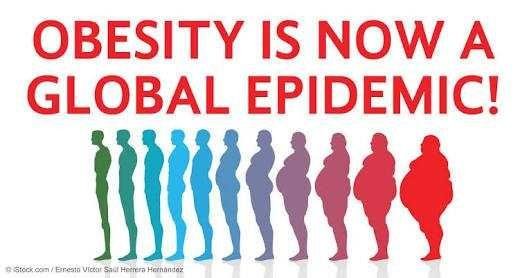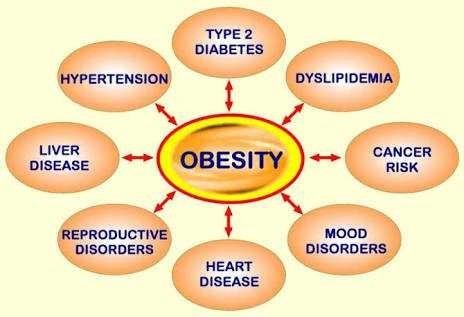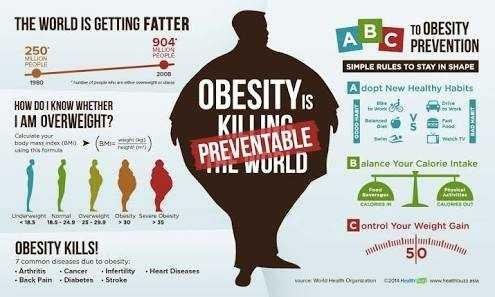Obesity
Obesity - A Preventable Disease
Abstract
Obesity is a common and preventable disease of clinical and public health importance. It is often a major risk factor for the development of several non-communicable diseases, significant disability and premature death. There is presently a global epidemic of obesity in all age groups and in both developed and developing countries. The increasing prevalence of obesity places a large burden on health care use and costs. Weight loss is associated with significant health and economic benefits. Effective weight loss strategies include dietary therapy, physical activity and lifestyle modification. Drug therapy is reserved for obese or overweight patients who have concomitant obesity-related risk factors or diseases. Population-wide prevention programmes have a greater potential of stemming the obesity epidemic and being more cost-effective than clinic-based weight-loss programmes. Ghana is going through an economic and nutrition transition and experiencing an increase in the prevalence of obesity and obesity-related illnesses, especially among women and urban dwellers. A national taskforce to address this epidemic and to draw up a national policy on related non-communicable diseases is urgently needed.
Keywords: Obesity, Overweight, Type 2 Diabetes Mellitus, Hypertension, Cardiovascular Disease, Non-communicable Disease


 bold
bold
Introdcution
Obesity is a common but often underestimated condition of clinical and public health importance in many countries around the world. Its general acceptance by many societies as a sign of well-being or a symbol of high social status, and the denial by health care professionals and the public alike that it is a disease in its own right, have contributed to its improper identification and management and the lack of effective public health strategies to combat its rise to epidemic proportions.
Obesity is defined as a condition of abnormal or excessive fat accumulation in adipose tissue, to the extent that health is impaired1. The amount of excess fat in absolute terms, and its distribution in the body - either around the waist and trunk (abdominal, central or android obesity) or peripherally around the body (gynoid obesity) - have important health implications.
In general, obesity is associated with a greater risk of disability or premature death due to type 2 diabetes mellitus (T2DM) and cardiovascular diseases (CVD) such as hypertension, stroke and coronary heart disease as well as gall bladder disease, certain cancers (endometrial, breast, prostate, colon) and non-fatal conditions including gout, respiratory conditions, gastro-esophageal reflux disease, osteoarthritis and infertility. Obesity also carries serious implications for psychosocial health, mainly due to societal prejudice against fatness.
A central distribution of body fat is associated with a higher risk of morbidity and mortality than a more peripheral distribution2. Furthermore, individuals with CVD risk factors such as T2DM, hypertension and smoking are exposed to significant health risks at lower levels of obesity. It is therefore imperative to assess individuals who are overweight or obese not only to determine the extent of adiposity, but also for the body fat distribution and the presence of co-morbid factors.
The body mass index (BMI) is a simple and commonly used parameter for classifying various degrees of adiposity. It is derived from the weight of the individual in kilograms divided by the square of the height in metres (kg/m2). By the current World Health Organisation (WHO) criteria, a BMI <18.5kg/m2 is considered underweight, 18.5–24.9 kg/m2 ideal weight and 25–29.9kg/m2 overweight or pre-obese. The obese category is sub-divided into obese class I (30–34.9kg/m2), obese class II (35–39.9kg/m2) and obese class III (≥40kg/m2)3. A BMI greater than 28kg/m2 in adults is associated with a three to four-fold greater risk of morbidity due to T2DM and CVDs than in the general population4.
Measurement of the waist circumference - measured at the midpoint between the lower border of the rib cage and the iliac crest5,6, or the waist:hip ratio (WHR)5 provide useful indices of abdominal fat accumulation and a better correlation with an increased risk of ill health and mortality than BMI alone2. An abdominal girth in excess of 108 cm (40 inches) for men and 98 cm (35 inches) for women or a WHR > 1.0 and 0.85 in men and women, respectively, are the currently accepted indicators of excessive abdominal fat accumulation which correlate with a substantially increased risk of metabolic complications3, 5.
Despite certain limitations with its use, there is general agreement with the applicability of BMI measurements for assessing underweight, overweight and obesity in adults. The case for children and adolescents is, however, different because unlike adults, BMI changes significantly with age during these stages of growth. In the late 1970's WHO recommended the use of a growth reference for young children developed by the United States National Centre for Health Statistics7. The data from which this reference was derived is now old and, based on children from only the USA, cannot realistically be applied to all populations worldwide. The WHO has recently replaced this reference with a new one which draws data from a community-based, multi-country study of infants and young children from birth to 6 years in all of the world's major regions, including developed and developing countries. Ghana was one of the six participating countries in the new study8. What is now awaited is a similar international growth reference for older children and adolescents. Until then, age and gender specific BMI charts derived from data sets from six different reference populations (Brazil, Great Britain, Hong Kong, the Netherlands, Singapore and the USA)9 could be used.
Epidemiology
There is presently a global epidemic of obesity in all age groups and in both developed and developing countries. In 1995, there were an estimated 200 million obese adults worldwide. As of 2000, the number of obese adults had increased to over 300 million. In developing countries, it is estimated that over 115 million people suffer from obesity-related problems10. A rapid increase in childhood obesity has also been reported10, 11.
Obesity among Ghanaian adults is common, particularly among the elderly, females and urban dwellers. A recent survey involving two urban and one rural community in the Greater Accra region showed an overall crude prevalence of obesity (BMI ≥ 30 kg/m2) of 20.2% and 4.6% for females and males, respectively. The age-standardized prevalence of adult obesity was 13.6%. Obesity increased with age, peaking in the 55 to 64-year age group. Residents from the high-class residential area had higher BMI compared to subjects from the lower class suburb. Urban residents had higher BMI compared to rural subjects12.
From a large body of evidence, the global epidemic of obesity has resulted mainly from societal factors that promote sedentary lifestyles and the consumption of high-fat, energy-dense diets (3). While genes are important in the determination of a person's susceptibility to weight gain13, obesity, by and large, occurs when energy intake from what is eaten and drank exceeds energy expenditure over a protracted period.
Obese children are more likely than their non-obese counterparts to grow into obese adults14. Data from a number of studies also provide robust evidence that children who are growth retarded at birth have an increased risk of becoming obese in later life15,16,17. This phenomenon, which implies foetal programming of adult obesity, is particularly likely to occur when a low body weight at birth from intrauterine growth retardation (IUGR) is over-compensated for by a catch-up growth in later life, and when this adiposity rebound occurs early in childhood16.
Once the obese state is established, as yet incompletely understood physiological processes maintain the new weight at a set level. Leptin, a protein hormone expressed predominantly by adipocytes, is believed to play a major role in this complex mechanism of weight maintenance. Leptin normally acts on receptors in the hypothalamus of the brain to inhibit food intake by counteracting the effects of potent feeding stimulants such as neuropeptide Y, while promoting the synthesis of α-MSH, an appetite suppressant18. Obese individuals, compared with their lean counterparts, have higher leptin levels19, suggesting a ‘leptin resistance’ rather than a deficiency in obese states.
Infrequently, obesity may be a manifestation of other medical conditions such as hypothyroidism, Cushing's syndrome and certain hypothalamic disorders, which should as much as possible be excluded on clinical grounds and occasionally by laboratory investigations before proceeding to manage patients.
Increased insulin secretion is a common consequence of obesity. The coexistence of hyperinsulinaemia with normal or elevated blood glucose levels in obese individuals suggests the presence of ‘insulin resistance’, now well accepted as the common underlying mechanism for a number of disease states including T2DM, hypertension, dyslipidaemia and cardiovascular diseases. The aggregation of several of these cardiovascular disease risk factors, including obesity, in the same patient indicates the presence of the metabolic syndrome20 which has significant implications for cardiovascular health.
The increasing prevalence of obesity places a large burden on health care use and costs. A few studies show that 2–7 % of total health care expenditure in a country may be directly attributable to obesity, with the costs of hypertension representing 53 – 60% of the total direct costs of obesity. On the other hand, weight loss in obese individuals is associated with both clinical and economic benefits3.
Weight Loss Strategies
Weight loss and maintenance strategies include dietary therapy, physical activity, lifestyle modification, behaviour therapy, pharmacotherapy and occasionally surgery. Using these techniques the goals are, at least to prevent further weight gain, or achieve weight reduction and maintain the lower body weight over a long term21.
Several expert panels have suggested the best methods of assessing and treating obesity. Currently, weight loss therapy is recommended for patients with a BMI ≥ 30 kg/m2 and those with a BMI between 25 and 29.9 kg/m2 or a high-risk waist circumference who additionally have two or more cardiovascular risk factors3,21. Treatment must be geared to a 10-percent body weight reduction over a 6-month period, at a rate of 0.5 to 1 kg per week (2 – 4 kg per month)21.
Dietary therapy should ensure an intake reduced by 500 to 1,000 kcal/day from the current level. Low calorie diets (LCDs) containing 1,000 to 1,200 kcal/day for most women and between 1,200 kcal/day and 1,600 kcal/day for men can result in sufficient weight reduction. Very low calorie diets (VLCDs) containing less than 800 kcal/day are no more effective than LCDs in producing weight loss and are to be discouraged21.
Physical activity increases energy expenditure and also reduces the risk of heart disease more than that achieved by weight loss alone. Physical activity (walking, dancing, gardening, household chores and team or individual sports) should be increased slowly to a level that ensures at least 30 minutes or more of moderate-intensity physical activity on most, and preferably all, days of the week. Behavioural strategies including self-monitoring, stress management and social support can enhance the gains from dietary methods and physical activity21.
Drug therapy should be used only in conjunction with diet, physical activity changes, and behaviour therapy and only when these measures have failed to promote weight loss after 6 months21. Orlistat, an oral pancreatic lipase inhibitor which inhibits the absorption of 30% of ingested fat from the intestine, is currently the only drug approved by the Ghana Food and Drugs Board for long-term treatment of obesity. Its side-effects may include abdominal pain, flatulence and oily stools following a meal containing fat.
Weight loss surgery, using various techniques, is an option only for well-informed and motivated patients who have clinically severe obesity (BMI ≥ 40 kg/m2) or a BMI ≥ 35 kg/m2 accompanied by serious co-morbid conditions21.
Preventive Strategies
Prevention is the key to controlling the obesity epidemic. The various prevention strategies recommended by the WHO include; a universal or public health approach directed at all members of a community; a selective approach directed at high-risk individuals and groups; and a targeted approach directed at individuals with weight-related problems and those at high risk of diseases associated with overweight and obesity. Of these the population-wide obesity prevention programs have a greater potential of stemming the obesity epidemic and being more cost-effective than the clinic-based treatments3. The WHO has further suggested the incorporation of the objectives of obesity prevention into the strategies and programmes for controlling other CVD-related non-communicable diseases (NCDs)3 since many of these conditions share common risk factors.
Ghana is going through an economic and nutrition transition and experiencing an increase in the prevalence of obesity and obesity-related illnesses. There is the need now, more than ever, to set up a multi-sectoral taskforce to assess the national prevalence, trends, determinants and impact of obesity and its related NCDs on the society as a whole and on health care provision in the country. The recommendations from such a consultation could show the way in which our environment can be made more enabling for adults and children to eat more healthily and be more physically active on a regular basis. Furthermore, such a taskforce can lay the foundation for the development of a National Policy on NCDs which will specify the responsibilities of government and the legislature on one hand and the private and public sectors involved in health, education, urban design, agriculture, food supply and the media on the other, in managing this preventable epidemic.